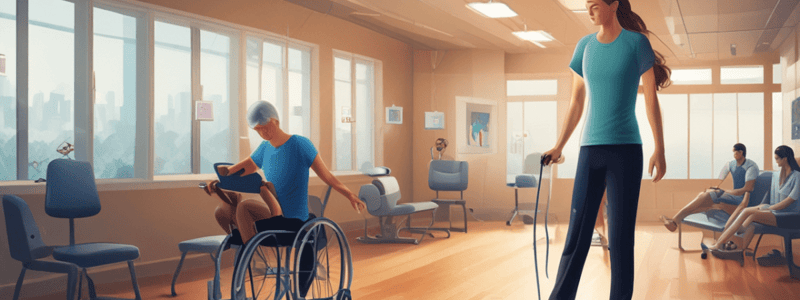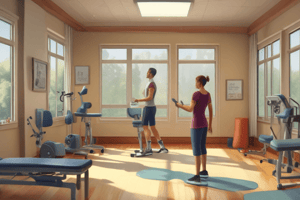Podcast
Questions and Answers
In what condition should active muscle contraction be avoided?
In what condition should active muscle contraction be avoided?
- During passive movements
- When applying ice to the affected area
- During active inflammation (correct)
- When the patient is in a postoperative phase
Which type of normal end feel is associated with soft tissue approximation?
Which type of normal end feel is associated with soft tissue approximation?
- Soft (correct)
- Firm
- Elastic
- Hard
Which scenario necessitates paying attention to the end feel during the examination?
Which scenario necessitates paying attention to the end feel during the examination?
- Conducting cardiovascular assessments
- Evaluating muscle strength
- Measuring body composition
- Assessing joint range of motion (correct)
What type of normal end feel is characterized by a bony sensation?
What type of normal end feel is characterized by a bony sensation?
When should a patient be restricted from moving a body part?
When should a patient be restricted from moving a body part?
What type of normal end feel is associated with soft tissue stretch?
What type of normal end feel is associated with soft tissue stretch?
Flashcards are hidden until you start studying
Study Notes
Passive Range of Motion (PROM)
- Goal: decrease complications arising from immobility, such as cartilage degeneration, adhesions, contracture, and decreased circulation
Indications for PROM
- Acute inflammation
- Active motion would be detrimental
- Patient unable to move a body part or not allowed to do so
Contraindications for PROM
- Extreme pain at rest
- Disruption of healing process
Limitations of PROM
- Does not prevent muscle atrophy
- Does not increase strength or endurance
- Does not increase circulation to the extent of active muscle contraction
Importance of End Feel
- Pay attention to end feel during treatment, especially after surgery while tissues are healing
Conditions for PROM
- Bed rest
- Paralysis
- Comatose
Normal End Feels
- Hard (bony)
- Firm (soft tissue stretch)
- Soft (soft tissue approximation)
Studying That Suits You
Use AI to generate personalized quizzes and flashcards to suit your learning preferences.



